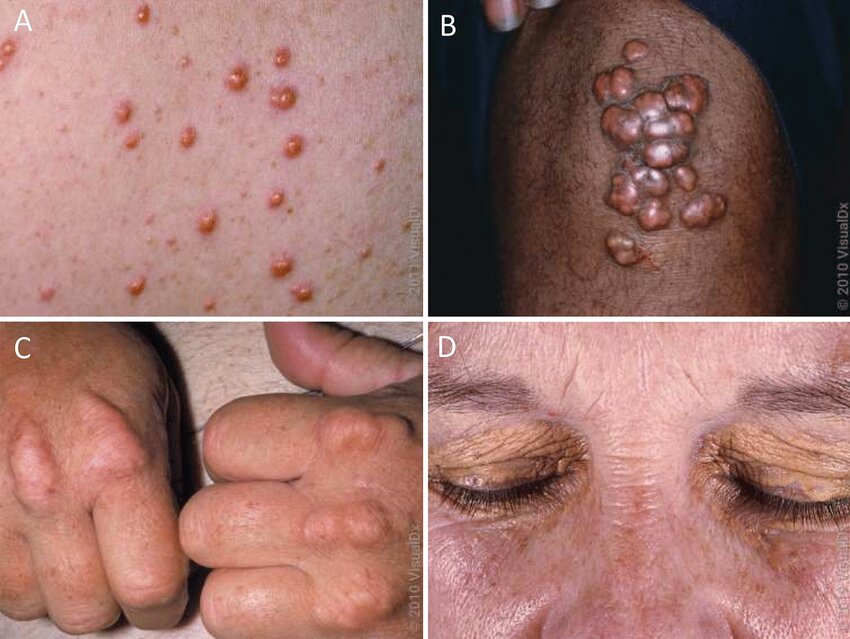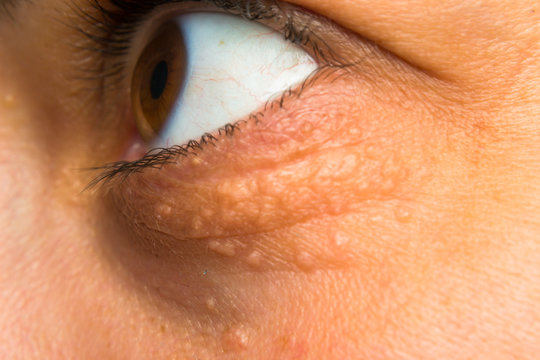Xanthoma: Symptoms, Causes, Treatment & Prevention
Introduction
Xanthoma refers to fatty deposits that develop in the skin or tendons, appearing as yellowish, raised bumps or plaques. These lesions usually indicate an underlying lipid metabolism disorder.

Types of Xanthoma
- Yellow Xanthomas: Flat, yellow plaques commonly found on eyelids (also called xanthelasma).
- Tendon Xanthomas: Nodules found over tendons such as Achilles or hand tendons.
- Eruptive Xanthomas: Small, yellowish bumps appearing suddenly, often on buttocks, shoulders, or arms.
- Tuberous Xanthomas: Larger nodules usually located on elbows and knees.
- Plane Xanthomas: Flat, yellowish patches on skin and mucous membranes.
Causes and Risk Factors
Xanthomas result from the accumulation of cholesterol-rich material in certain tissues due to:
- Hyperlipidemia: High levels of cholesterol or triglycerides in the blood.
- Familial lipid disorders: Genetic conditions like familial hypercholesterolemia.
- Diabetes mellitus: Poorly controlled blood sugar can contribute.
- Primary biliary cirrhosis and other liver diseases.
- Hypothyroidism: Low thyroid hormone levels can elevate lipid levels.

Symptoms and Signs
- Yellow to orange raised lesions on skin or tendons.
- Lesions may be painless but cosmetically concerning.
- Tendon xanthomas can cause discomfort or interfere with joint movement.
- Eruptive xanthomas often itch and appear suddenly.
Diagnosis
Diagnosis is based on clinical examination and history. Additional tests include:
- Blood lipid profile to evaluate cholesterol and triglyceride levels.
- Family history assessment for genetic lipid disorders.
- Skin biopsy (rarely needed) to confirm diagnosis.
Treatment
1. Managing Lipid Levels
- Lifestyle changes: Healthy diet, weight management, regular exercise.
- Medications: Statins, fibrates, niacin, or other lipid-lowering agents.
- Treat underlying conditions such as diabetes or hypothyroidism.
2. Removing Xanthomas
- Surgical excision: For cosmetic or functional reasons.
- Laser therapy: Effective for superficial lesions.
- Cryotherapy: Freezing lesions to remove them.
Prevention
- Maintain healthy cholesterol and triglyceride levels.
- Adopt a balanced diet low in saturated fats and trans fats.
- Exercise regularly to promote healthy lipid metabolism.
- Manage chronic diseases like diabetes and hypothyroidism promptly.
When to See a Doctor
Consult a healthcare provider if you notice new yellowish bumps or plaques on your skin or tendons, especially if you have a family history of cholesterol problems or cardiovascular disease.
Conclusion
Xanthomas are visible signs of underlying lipid metabolism disorders. Early diagnosis and treatment help manage cholesterol levels, reduce cardiovascular risks, and improve cosmetic outcomes. Lifestyle modifications combined with medical treatment are essential for effective management.

